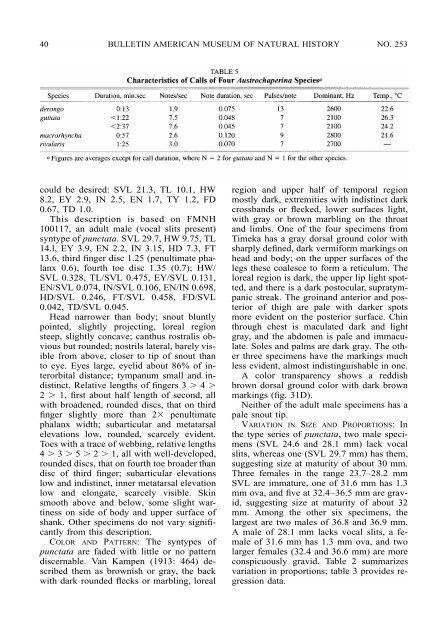SPHENOPHRYNE - American Museum of Natural History
SPHENOPHRYNE - American Museum of Natural History
SPHENOPHRYNE - American Museum of Natural History
You also want an ePaper? Increase the reach of your titles
YUMPU automatically turns print PDFs into web optimized ePapers that Google loves.
40 BULLETIN AMERICAN MUSEUM OF NATURAL HISTORY NO. 253<br />
could be desired: SVL 21.3, TL 10.1, HW<br />
8.2, EY 2.9, IN 2.5, EN 1.7, TY 1.2, FD<br />
0.67, TD 1.0.<br />
This description is based on FMNH<br />
100117, an adult male (vocal slits present)<br />
syntype <strong>of</strong> punctata. SVL 29.7, HW 9.75, TL<br />
14.l, EY 3.9, EN 2.2, IN 3.15, HD 7.3, FT<br />
13.6, third finger disc 1.25 (penultimate phalanx<br />
0.6), fourth toe disc 1.35 (0.7); HW/<br />
SVL 0.328, TL/SVL 0.475, EY/SVL 0.131,<br />
EN/SVL 0.074, IN/SVL 0.106, EN/IN 0.698,<br />
HD/SVL 0.246, FT/SVL 0.458, FD/SVL<br />
0.042, TD/SVL 0.045.<br />
Head narrower than body; snout bluntly<br />
pointed, slightly projecting, loreal region<br />
steep, slightly concave; canthus rostralis obvious<br />
but rounded; nostrils lateral, barely visible<br />
from above, closer to tip <strong>of</strong> snout than<br />
to eye. Eyes large, eyelid about 86% <strong>of</strong> interorbital<br />
distance; tympanum small and indistinct.<br />
Relative lengths <strong>of</strong> fingers 3 4 <br />
2 1, first about half length <strong>of</strong> second, all<br />
with broadened, rounded discs, that on third<br />
finger slightly more than 2 penultimate<br />
phalanx width; subarticular and metatarsal<br />
elevations low, rounded, scarcely evident.<br />
Toes with a trace <strong>of</strong> webbing, relative lengths<br />
4 3 5 2 1, all with well-developed,<br />
rounded discs, that on fourth toe broader than<br />
disc <strong>of</strong> third finger; subarticular elevations<br />
low and indistinct, inner metatarsal elevation<br />
low and elongate, scarcely visible. Skin<br />
smooth above and below, some slight wartiness<br />
on side <strong>of</strong> body and upper surface <strong>of</strong><br />
shank. Other specimens do not vary significantly<br />
from this description.<br />
COLOR AND PATTERN: The syntypes <strong>of</strong><br />
punctata are faded with little or no pattern<br />
discernable. Van Kampen (1913: 464) described<br />
them as brownish or gray, the back<br />
with dark rounded flecks or marbling, loreal<br />
region and upper half <strong>of</strong> temporal region<br />
mostly dark, extremities with indistinct dark<br />
crossbands or flecked, lower surfaces light,<br />
with gray or brown marbling on the throat<br />
and limbs. One <strong>of</strong> the four specimens from<br />
Timeka has a gray dorsal ground color with<br />
sharply defined, dark vermiform markings on<br />
head and body; on the upper surfaces <strong>of</strong> the<br />
legs these coalesce to form a reticulum. The<br />
loreal region is dark, the upper lip light spotted,<br />
and there is a dark postocular, supratympanic<br />
streak. The groinand anterior and posterior<br />
<strong>of</strong> thigh are pale with darker spots<br />
more evident on the posterior surface. Chin<br />
through chest is maculated dark and light<br />
gray, and the abdomen is pale and immaculate.<br />
Soles and palms are dark gray. The other<br />
three specimens have the markings much<br />
less evident, almost indistinguishable in one.<br />
A color transparency shows a reddish<br />
brown dorsal ground color with dark brown<br />
markings (fig. 31D).<br />
Neither <strong>of</strong> the adult male specimens has a<br />
pale snout tip.<br />
VARIATION IN SIZE AND PROPORTIONS: In<br />
the type series <strong>of</strong> punctata, two male specimens<br />
(SVL 24.6 and 28.1 mm) lack vocal<br />
slits, whereas one (SVL 29.7 mm) has them,<br />
suggesting size at maturity <strong>of</strong> about 30 mm.<br />
Three females in the range 23.7–28.2 mm<br />
SVL are immature, one <strong>of</strong> 31.6 mm has 1.3<br />
mm ova, and five at 32.4–36.5 mm are gravid,<br />
suggesting size at maturity <strong>of</strong> about 32<br />
mm. Among the other six specimens, the<br />
largest are two males <strong>of</strong> 36.8 and 36.9 mm.<br />
A male <strong>of</strong> 28.1 mm lacks vocal slits, a female<br />
<strong>of</strong> 31.6 mm has 1.3 mm ova, and two<br />
larger females (32.4 and 36.6 mm) are more<br />
conspicuously gravid. Table 2 summarizes<br />
variation in proportions; table 3 provides regression<br />
data.
















